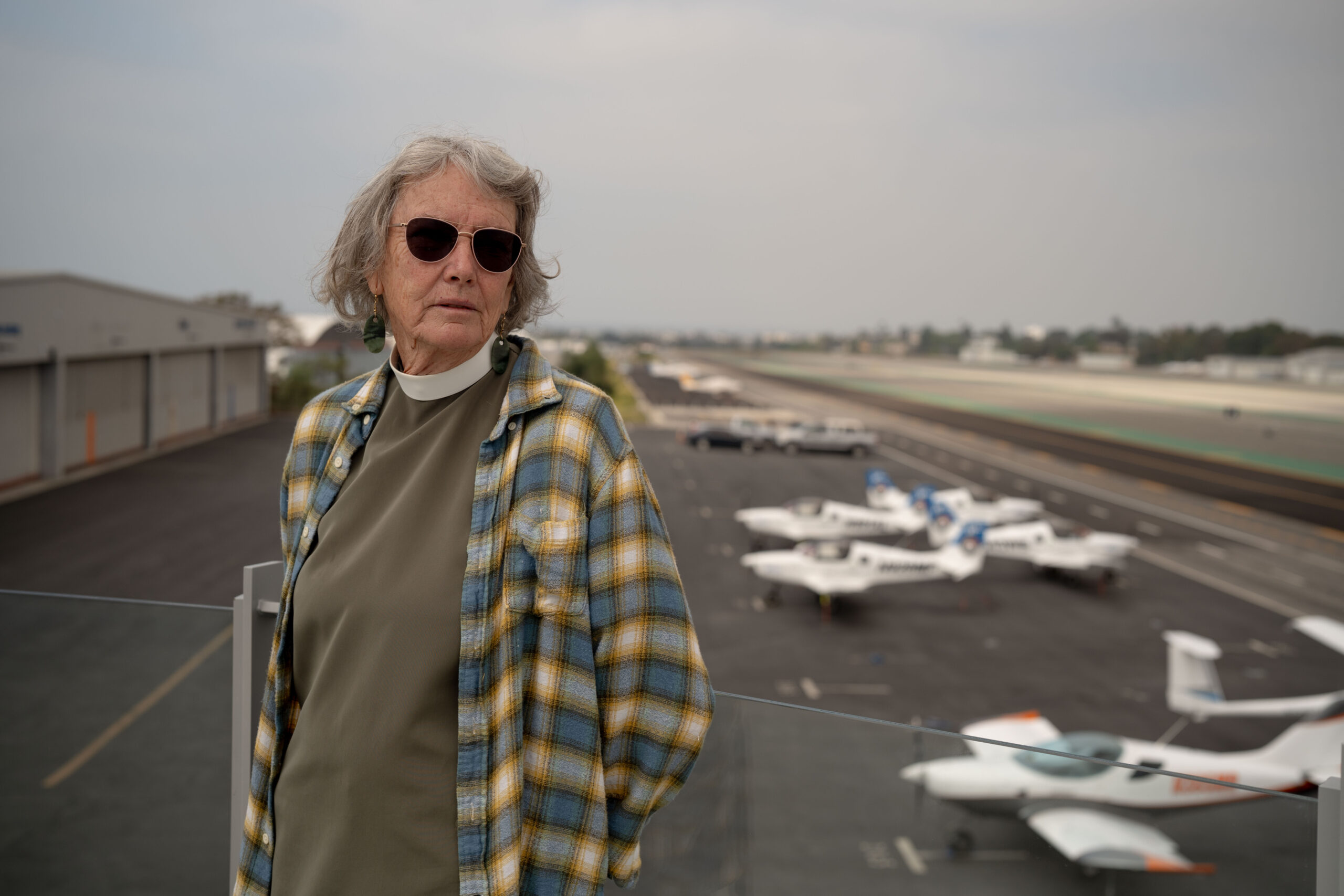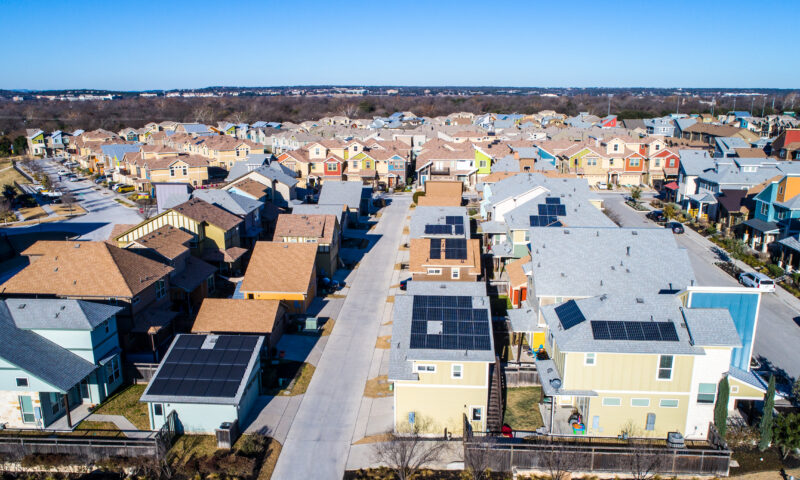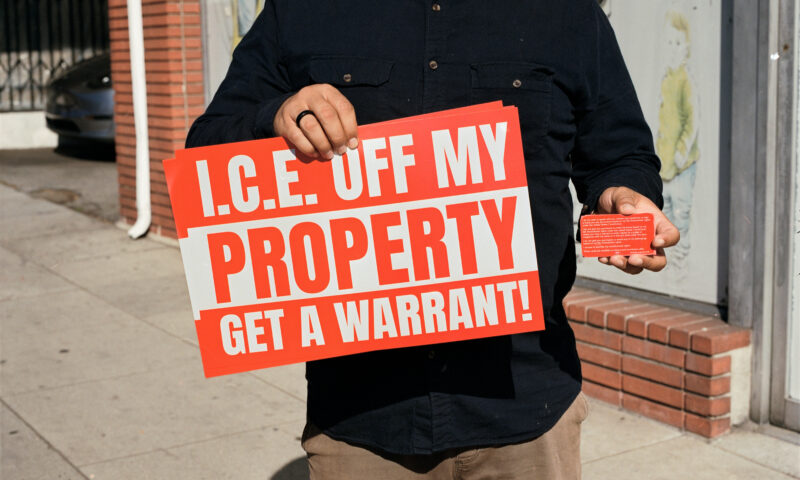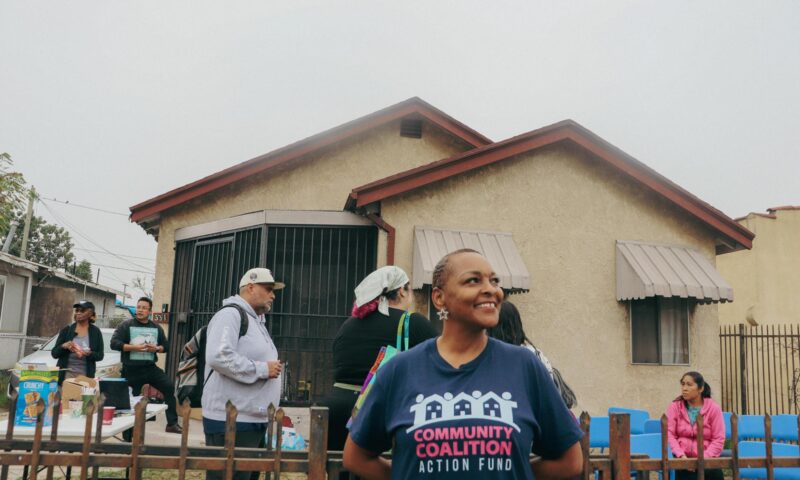This article was produced in partnership with KCRW.
In the neighborhoods surrounding the Santa Monica Airport, homeowners know little peace. Every few minutes, the whine of a jet engine intrudes on the suburban soundscape.
But relief is coming. In 2017, locals won a more than seven-decade fight to close the airport. It is scheduled to shutter once and for all on Dec. 31, 2028.
Santa Monica residents voted in 2014 to build a park on the site of the airport. But as the 2028 closure date approaches, some residents, councilmembers and pro-housing groups are calling for the construction of affordable housing on the site in addition to a park.
With an organized contingent of development opponents determined to stop them, the airport site is shaping up as the latest flashpoint in Southern California’s battles over housing construction.
Neighbors of the airport say living beneath the jets is maddening and dangerous — many of the smaller planes that land there burn leaded fuel, spraying toxins on the homes and schools below. But some of the airport’s neighbors are so opposed to housing construction that they would consider keeping the airport open until the threat of development is quashed.
“A lot of the risk could be reduced simply by delaying closing,” said Marc Verville, who lives near the airport.
“To protect ourselves, we should keep the airport open until we can address the political landscape and correct it,” said Tricia Crane, chair of Northeast Neighbors of Santa Monica, a neighborhood association.
The closure of an airport presents a rare opportunity in any urban environment. Spanning more than 200 acres — and comprising around 4% of the city’s land — the Santa Monica Airport is poised to become available for redevelopment all at once. Centrally located and publicly owned, it offers a rare chance to address the city’s acute affordable housing shortage. In Santa Monica, where average rent is nearly $4,000 a month, such a moment may never come again.
Building housing “would be a win for everybody,” said Rev. Joanne Leslie, a Santa Monica resident and a deacon in the Episcopal Diocese of Los Angeles. Leslie is part of a group advocating for a 3,000-unit affordable housing development on the airport site called Cloverfield Commons.
Leslie’s group imagines their development amidst the larger park, with buildings arranged around smaller, so-called pocket parks, connected by winding paths.

Rev. Joanne Leslie is part of a group advocating for an affordable housing development on the airport site.
Building a large amount of housing on the site would likely require voter approval through another ballot measure, according to City Councilmember Jesse Zwick, who supports building “some form of mixed use, mixed income housing” on the site alongside a park.
But he says the housing crisis in Santa Monica is so great that another referendum — even if it means a difficult fight — would be worth having.
For every four or five new jobs created in Santa Monica over the past 45 years, the city added just one home, he said. The city’s failure to build housing has led its population to stagnate during that time period, he added, while California’s population has nearly doubled.
“Will it be a fight? Sure,” he said. “But is it one that I think can be won? Definitely.”
Since the 1970s, anti-development groups have largely blocked the construction of new housing across the state — and especially in Santa Monica, where the city has permitted roughly 4,500 units of new housing in the last 20 years.
Given the statewide housing shortage, state officials are asking cities to build more housing than they used to. Every eight years, cities are required to submit a plan to the state showing how they intend to meet its increasingly ambitious housing development targets. If they don’t adequately plan to meet those targets, they could face penalties including the notorious “builder’s remedy,” in which developers are allowed to build whatever they want, regardless of zoning, as long as 20% of the units are affordable.
Verville and Crane are worried Santa Monica will designate the airport site for housing in its next state-mandated housing plan, due in 2029.
That’s why they are floating the idea of pushing to delay the closure of the airport until after that deadline as a way to keep the airport out of conversations about meeting state housing targets.
“The residents want to stop the airport conversion process until this kind of risk is addressed and mitigated,” said Crane, “and we can fulfill our vision of a park.”
* * *
Leslie was drawn to the fight to build affordable housing on the airport site because of her work as a deacon in the Episcopal Church advocating for workers and immigrant rights. Leslie is a member of Clergy and Laity United for Economic Justice (CLUE), which recently participated in the Home Is Sacred rally in support of affordable housing development on the airport site.
“In a place like Santa Monica, so much of the homelessness is directly related to the high cost of housing and rents,” she said. “We put people in a situation where they can’t help themselves, and then we blame them for it.”
Crane and Verville say they’re not opposed to affordable housing, but that the city, facing a budget deficit, cannot afford to build any and that no subsidies exist to support buildings with lower rents.
“My kids want a lot of things too,” said Crane. “If I don’t have the money for it, they don’t get it.”
Leslie’s group contends that subsidies do exist to build affordable housing on the site, including funds raised by Measure A, the county’s new half-cent sales tax, approved by voters in November and aimed at funding homelessness solutions and affordable housing.

Planes parked on the tarmac of the Santa Monica Airport.
Verville and Crane think that’s not realistic, and that the development at the site will be exclusively luxury apartments, which they say will make the city more expensive, not less.
They arrived for their interviews at the airport armed with more than 90 pages of readings, including an academic working paper they said debunks the idea that building market-rate housing lowers rents and home prices. (The National Bureau of Economic Research study finds that higher housing costs are tied to a region’s income growth, not to how tightly its housing supply is regulated.)
“It’s becoming a city of rich people,” Crane sighed.
Santa Monica City Councilmember Zwick says that building housing, including luxury housing, does lead to lower rents and housing prices in the surrounding community.
About 80% of the time, new apartments are filled by people already living nearby, he said.
“And when those people move into those new housing units, they open up housing in the spaces where they used to live, creating more available supply and creating downward pressure on prices.”
“Every credible study I’ve read indicates that that’s how it works,” he said, speaking with Capital & Main in an empty office at UCLA, where he is studying for a master’s in urban planning.
Besides, Zwick argued, parks and housing belong together. Apartments lacking backyards need open, public space. And parks need those who live nearby to use them.
“A lot of people like to say we need our Central Park,” he said. “But if Central Park in Manhattan had a perimeter entirely of single family homes, it wouldn’t function and be as great as it is.”
Copyright 2025 Capital & Main.
All photos by Jeremy Lindenfeld.


 The SlickNovember 14, 2025
The SlickNovember 14, 2025
 Latest NewsNovember 11, 2025
Latest NewsNovember 11, 2025
 The SlickNovember 12, 2025
The SlickNovember 12, 2025
 Column - State of InequalityNovember 13, 2025
Column - State of InequalityNovember 13, 2025
 Latest NewsNovember 19, 2025
Latest NewsNovember 19, 2025
 Latest NewsNovember 18, 2025
Latest NewsNovember 18, 2025
 Latest NewsNovember 17, 2025
Latest NewsNovember 17, 2025
 The SlickNovember 18, 2025
The SlickNovember 18, 2025



